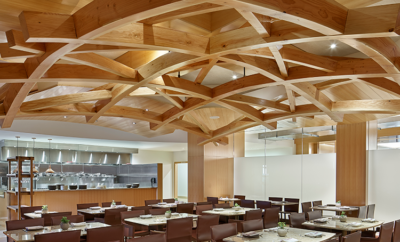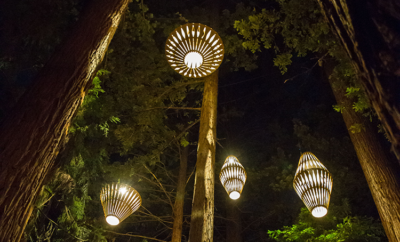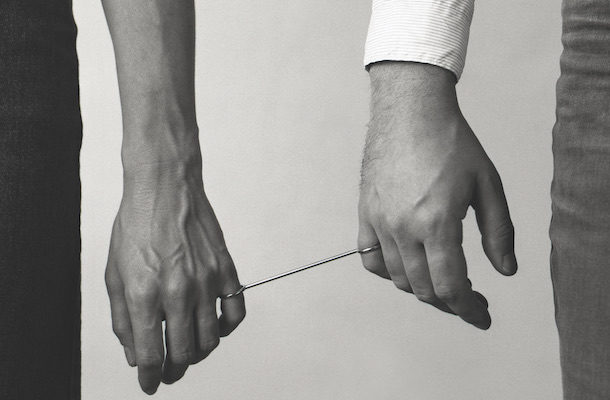 Ring für zwei Personen (Ring for Two Persons), Otto Künzli, 1980. OTTO KÜNZLI PHOTO.
Ring für zwei Personen (Ring for Two Persons), Otto Künzli, 1980. OTTO KÜNZLI PHOTO.
Feature
Two for the Show: Jewelry’s Power Couples
JEWELRY IS THE MOST INTIMATE ART FORM, characterized by a symbiotic relationship with the human body. It functions by touch, embracing one’s ears, neck, chest, wrists, and fingers. Jewelry is seductive. Not surprisingly, many jewelers fall in love with one another. In fact, some of the most notable jewelers of the past seventy years—including several of the field’s superstars—have chosen to marry. Might it be the allure associated with jewelry that attracts these artists romantically? Or simply a common aesthetic and shared passion? Whatever the reasons, making jewelry evidently makes for love. Some jewelry-making couples who cohabitate also collaborate, while others are amorous partners but create artworks autonomously. However one looks at it, the work they generate, either alone or together, would not be the same without the closeness of their relationships. Unlike contemporary jewelry couples, most of whom met in art school, mid-century modernist jewelers found their mates in distinctive ways.
Sam and Carol Kramer
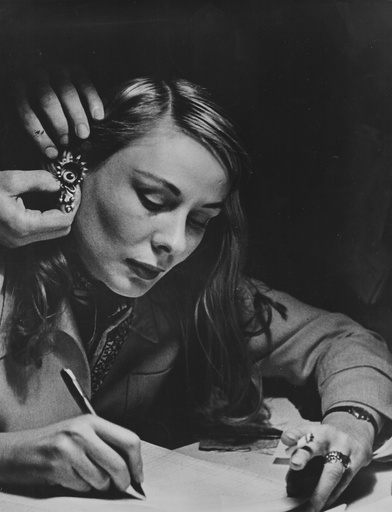
Carol Kramer with Sam Kramer’s hand holding an earring, 1940s–1950s.
Sam and Carol (née Enners) Kramer ran a fabled second-floor studio/shop on 8th Street in New York’s Greenwich Village from 1940 until Sam’s death from a heart attack in 1964. Presented as a surreal nightmare, with the catchphrase “fantastic jewelry for people who are slightly mad,” the store drew patrons through Sam’s tongue-in-cheek marketing ploys, which included a window featuring eerie biomorphic figures and symbols, and bronze doorknobs cast in the form of human hands. Although she hasn’t received sufficient credit thus far, Carol often collaborated with Sam, as she did on the provocative, sexually charged Lovers.
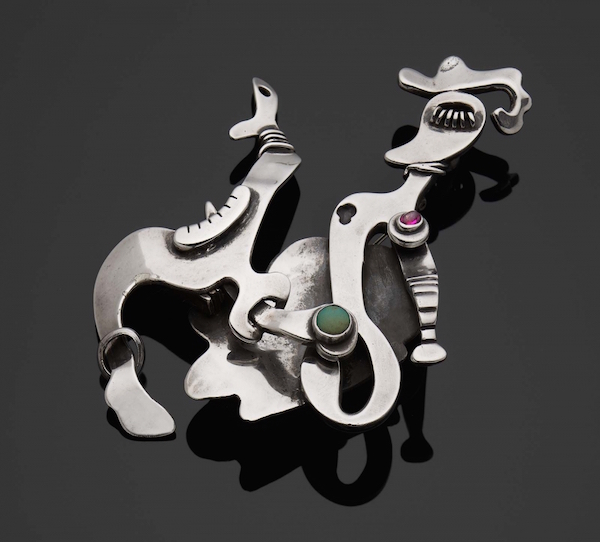
Lovers by Sam Kramer and Carol Kramer, brooch, 1949. Silver, turquoise, garnet. Museum of Fine Arts, Boston, Daphne Farago Collection © Estate of Sam Kramer Photos © Museum of Fine Arts, Boston.
She, in fact, designed and/or fabricated several of the shop’s offerings. A fashion model from Brooklyn, Carol met Sam when she wandered into his first establishment on West 3rd Street in 1939. Inspired by the densely layered, wildly expressive figures she saw there, she soon tried her own hand at jewelry-making. After being impressed by Carol’s initial attempts to forge a ring, Sam taught her metalsmithing.
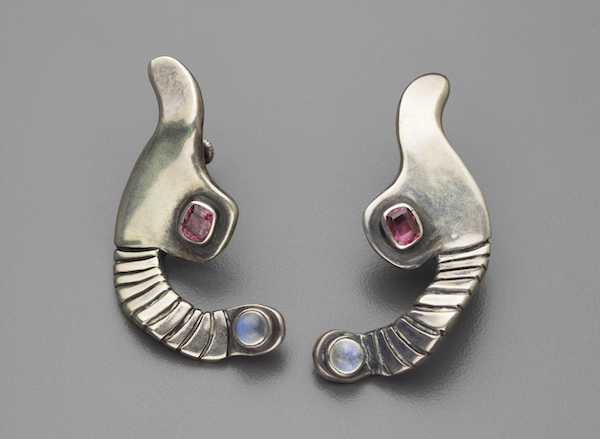
Pair of earrings by Sam Kramer, c. 1950. Silver, moonstone and amethyst. Museum of Fine Arts, Boston, Daphne Farago Collection © Estate of Sam Kramer Photos © Museum of Fine Arts, Boston.
Carol avidly supported Sam’s eccentricities, living with him behind a screen in the rear of their store, where they slept on a collapsible cot; she cooked on a hot plate, and gleefully looked on while her husband greeted customers in his pajamas. A passionate “rock hound,” Sam incorporated semiprecious stones, rough minerals, and glass taxidermy eyes into many of his works. In keeping with his proclamation, “if it’s stone, I’ll use it,” Sam was dismayed when Carol mislaid her recently removed gallstones, since he had planned to feature them in a bracelet. Although the couple, who married in 1940, divorced in 1957, Carol returned to the shop in 1962, after Sam’s brief marriage to his second wife ended. She ran the operation until an auto accident in 1970 forced her into temporary retirement, from which time, until its closure in 1974, it was maintained by Sam and Carol’s older son, John.
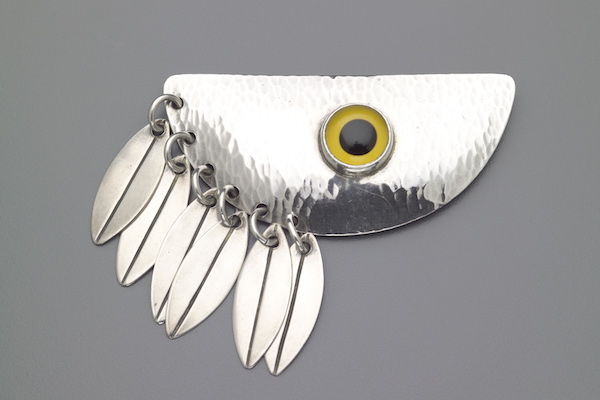
Brooch by Sam Kramer, 1950–60. Silver with yellow glass taxidermy eye. Museum of Fine Arts, Boston, Daphne Farago Collection © Estate of Sam Kramer Photos © Museum of Fine Arts, Boston.
There are many other noteworthy couples working in jewelry today, such as Germans Norman Weber and Christiane Förster, Georg Dobler and Margit Jäschke, and Bettina Dittlmann and Michael Jank; Italians Annamaria Zanella and Renzo Pasquale; Israel-born Attai Chen and his German-Iranian partner, Carina Shoshtary; and Stockholm-based Adam Grinovich and Annika Pettersson, and Beatrice Brovia and Nicolas Cheng. Brovia and Cheng, like the others, maintain separate practices, but since 2011 have collaborated on a joint project that focuses on interdisciplinary material research and craft discourse through installations, objects, and jewelry. All in all, whether by a common intellect and aesthetic sensibility, compatible theoretical bent, physical attraction, or simply the mystery of love, one fact is certain: couples who make jewelry turn each other on.
Toni Greenbaum is an art historian specializing in twentieth- and twenty-first-century jewelry and metalwork.
This article has been updated to correct two errors that appeared in our Summer print issue: the proper photograph is shown with the discussion of Sam and Carol Kramer; and the caption to the image of Gijs Bakker and Emmy van Leersum’s Clothing Suggestions has been corrected.


